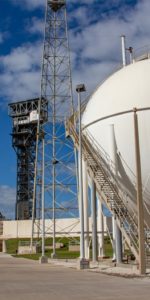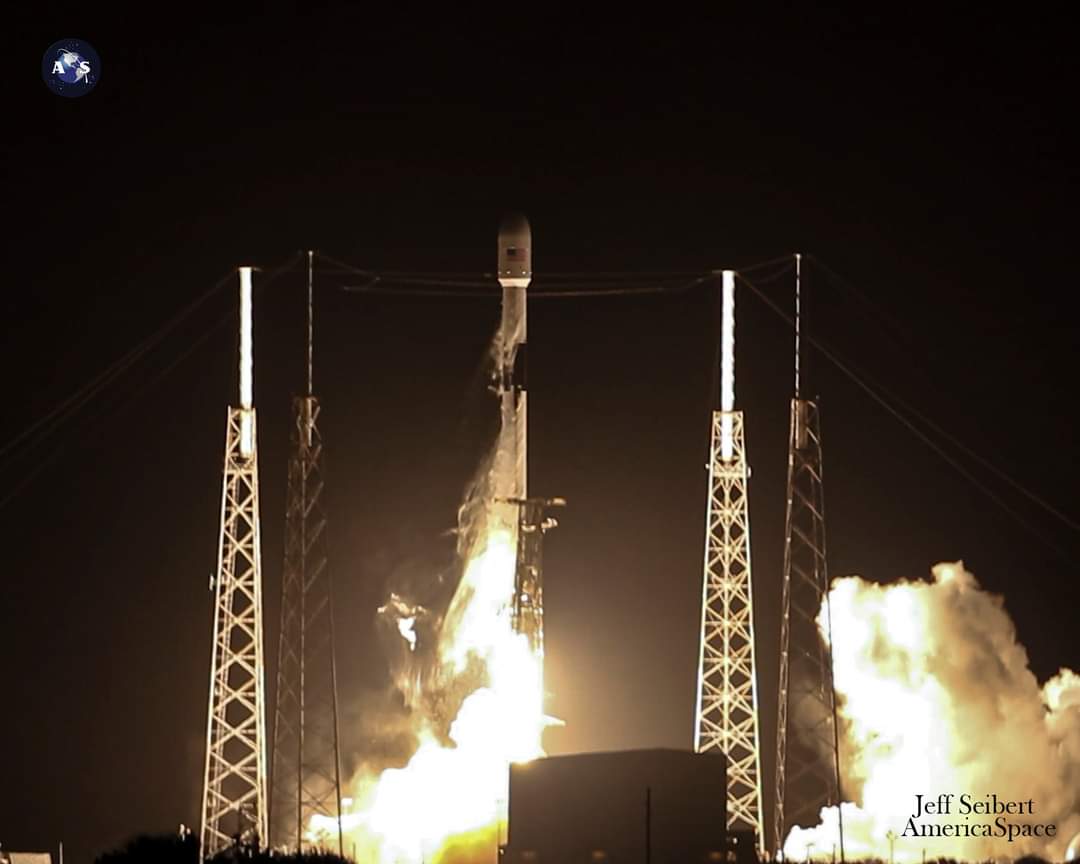
SpaceX has successfully flown its 20th Falcon 9 of the year, with the just-after-sunset climb to orbit of the brand-new B1062 core and the fourth Block III Global Positioning System (GPS) navigation and timing satellite for the U.S. Space Force. Liftoff occurred at 6:24 p.m. EST Thursday from Space Launch Complex (SLC)-40 at Cape Canaveral Air Force Station, Fla., and GPS III-04 was successfully inserted into Medium Earth Orbit (MEO) at an altitude of 12,550 miles (20,200 km) about 89 minutes later.
With this mission already more than a month overdue, next up on 14 November from historic Pad 39A at the Kennedy Space Center (KSC) is the flight of Dragon Resilience astronauts Mike Hopkins, Victor Glover, Shannon Walker and Soichi Noguchi for the first regular crew-rotation to the International Space Station (ISS). Their launch will mark the 21st Falcon 9 flight of 2020, tying with 2018 as SpaceX’s most-flown year.
Weather conditions for Thursday’s opening launch attempt were projected to be marginal, with a 60-percent likelihood of acceptable conditions at T-0, deteriorating markedly to only 40-percent favorable in the event of a 24-hour scrub to Friday.
“A tight pressure gradient is being generated between the strong high-pressure area anchored over the North Atlantic and Tropical Storm Eta over Central America,” noted the 45th Weather Squadron at Patrick Air Force Base in its Wednesday morning update. “This creates breezy onshore flow along the Space Coast, with rain shower chances increasing over time.”
All told, this picture produced the principal concerns of violating the Cumulus Cloud Rule and exceeding Liftoff Winds limitations. Conditions on Friday were set to worsen, as Eta’s progress adds moisture and strengthening winds over the Spaceport.
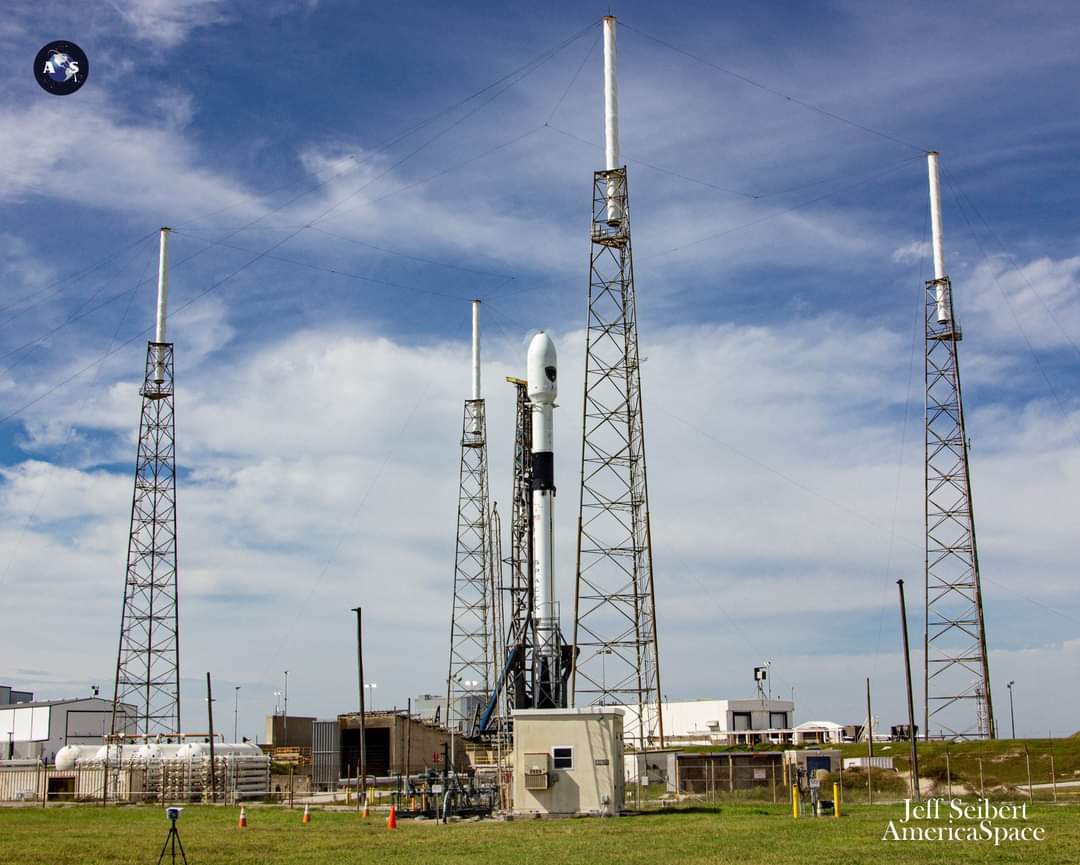
Launch of GPS III-04 was originally scheduled for late September, but delays to an earlier Falcon 9 mission and shifting prioritization of Eastern Range assets pushed it back to 9:43 p.m. EDT on 2 October. B1062 became only the third “new” first stage to fly in 2020, coming on the heels of B1058 which lifted Dragon Endeavour on 30 May and B1060 which boosted the GPS III-03 mission aloft on 30 June. In fact, including tonight’s launch, the 20 Falcon 9 missions flown so far this year have been accomplished with only nine booster cores, one of which has recorded no fewer than four flights since January.
Countdown operations as night fell on 2 October proceeded normally, as fueling of the Falcon 9 with its flight load of liquid oxygen and a highly refined form of rocket-grade kerosene (known as “RP-1”) commenced at T-35 minutes. The only issue of concern seemed to be the intractable Florida weather, which, although nominally “Green”, remained marginal in terms of potential violations of the Thick Cloud Rule.
It came as more than a surprise, therefore, when the mission was dramatically aborted at T-2 seconds—after the commands had been transmitted to start the nine Merlin 1D+ first-stage engines—and a slight flicker of flame was promptly followed by the ominous silence of shutdown and a dramatic pall of smoke which drifted off into the night sky.
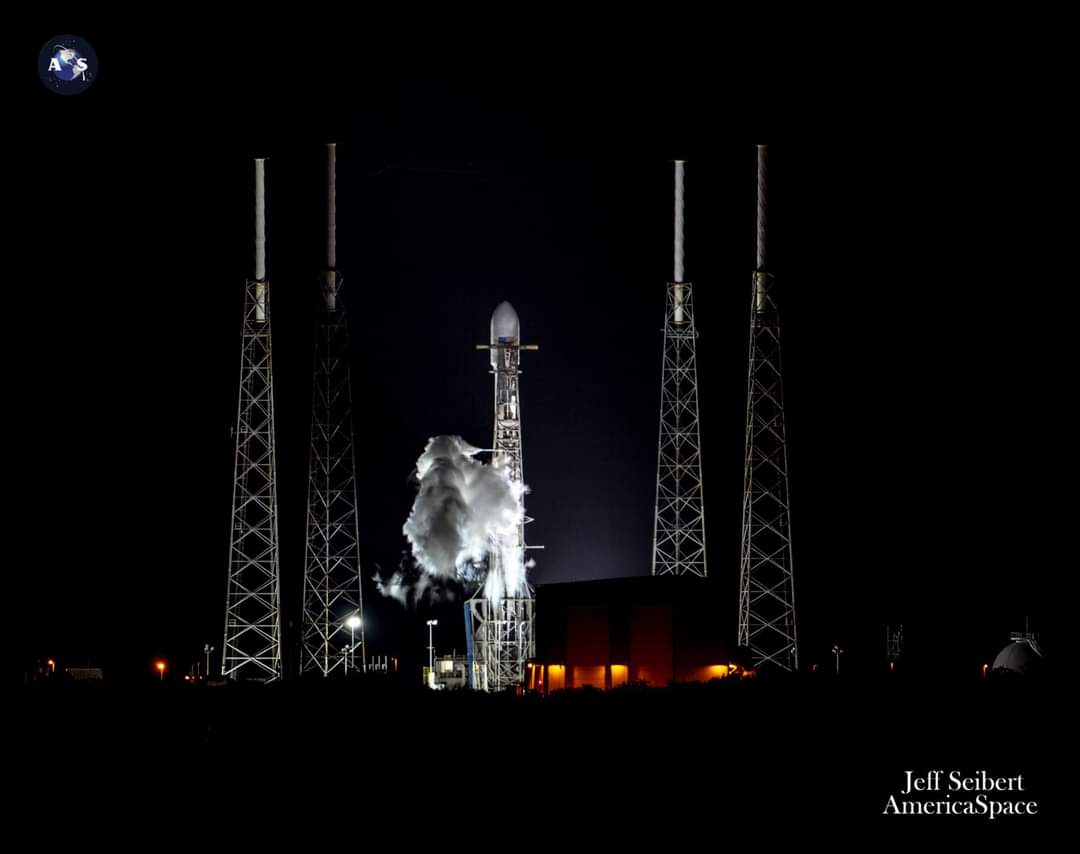
“And we have an abort,” came the clipped call from the SpaceX launch commentator. “All engines in standby.”
Although it was noted that the earliest next opportunity for the mission to fly would be on 3 October at 9:39 p.m. EDT, it soon became clear that a more serious incident had arisen. SpaceX founder Elon Musk later attributed the cause of the abort to an “unexpected pressure rise in the turbomachinery gas generator”.
As investigators dug into the issue, on 10 October NASA and SpaceX announced that Crew-1—previously targeted for 31 October—had correspondingly slipped until early-to-mid November. It was noted that the delay allowed “additional time for SpaceX to complete hardware testing and data reviews as the company evaluates off-nominal behavior of the Falcon 9 first-stage gas generators”.
B1062 was put through a customary Static Fire Test of the nine first-stage engines on Sunday, which enabled SpaceX to formally announce Thursday, 5 November as the next targeted launch date. Fueling of the 230-foot-tall (70-meter) booster with liquid oxygen and a highly refined form of rocket-grade kerosene (known as “RP-1”) commenced about 35 minutes prior to liftoff and B1062 blazed into the the darkening Florida sky at 6:24 p.m. EST, less than an hour after local sunset.
The core was discarded about four minutes into ascent, after which it began its descent to land on the deck of the Autonomous Spaceport Drone Ship (ASDS), “Of Course I Still Love You”, situated in the Atlantic Ocean, about 390 miles (620 km) off the Florida coast.
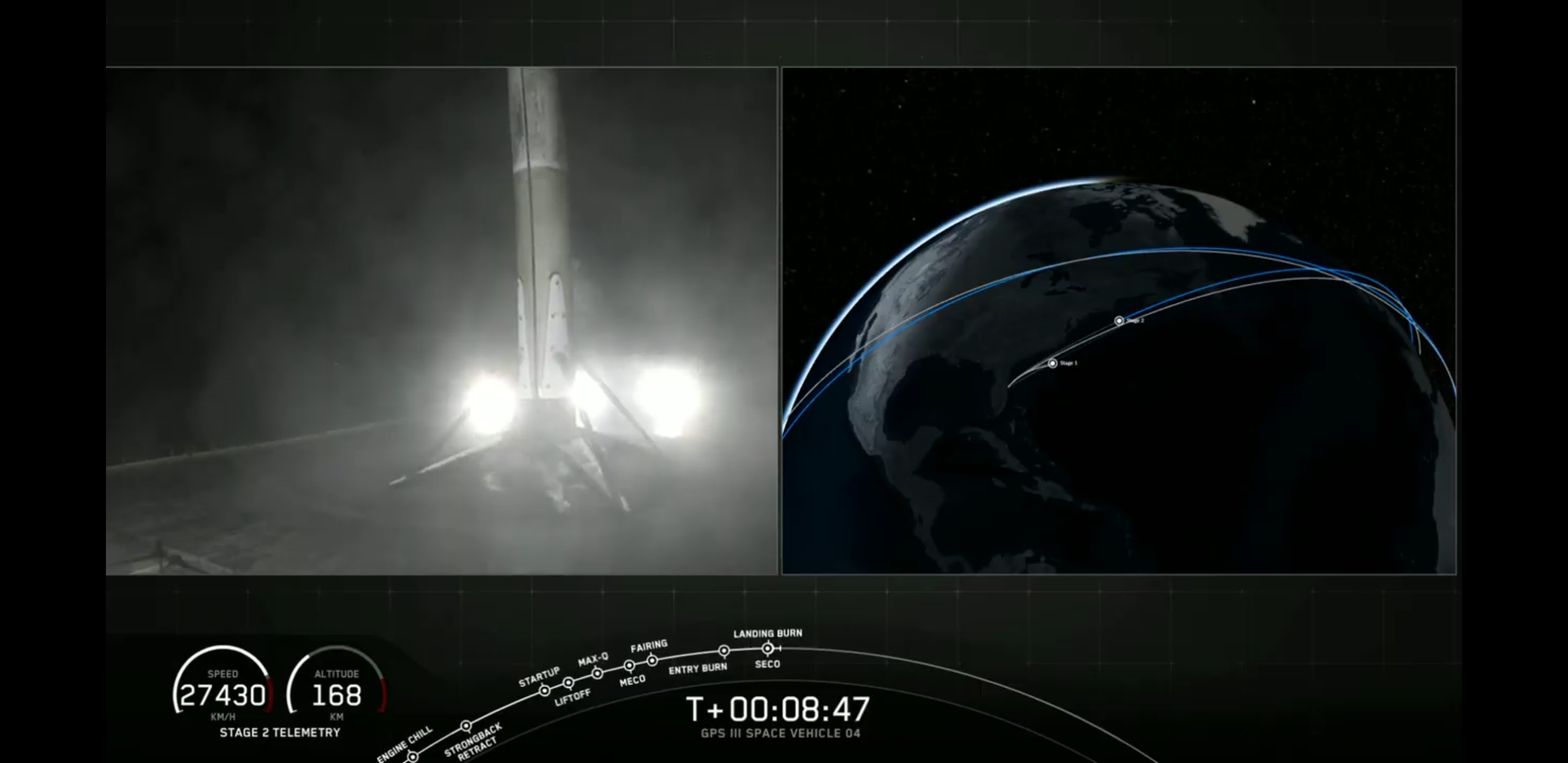
Meanwhile, two “burns” of the upper stage’s Merlin 1D+ Vacuum engine—the first lasting 5.5 minutes, the second for just 45 seconds—deliver and position GPS III-04 for deployment at 89 minutes after launch. It represents the fourth Block III mission and the third to ride a Falcon 9, following previous flights in December 2018 and last June. Another satellite flew on the Delta IV Medium’s last mission in August 2019, with a fifth earmarked to ride a previously-flown Falcon 9 core next year.
Building upon a GPS Navstar heritage dating back to the 1970s, Block III got underway almost two decades ago and the Air Force awarded Lockheed Martin a $1.4 billion contract in May 2008 to develop the first two Block III satellites in what will eventually comprise a 32-satellite network, with the first launch initially targeted for 2014. However, payload difficulties would ultimately push the program’s maiden flight back by almost five years and it did not launch until December 2018.
Following a Request for Proposals (RFP) issued by the Air Force in June 2017 for the fourth, fifth and sixth GPS Block III missions, SpaceX received the $290.5 million contract in March 2018. Although SpaceX has successfully delivered two Block IIIs to orbit in December 2018 and June 2020, both flew under separate contracts.
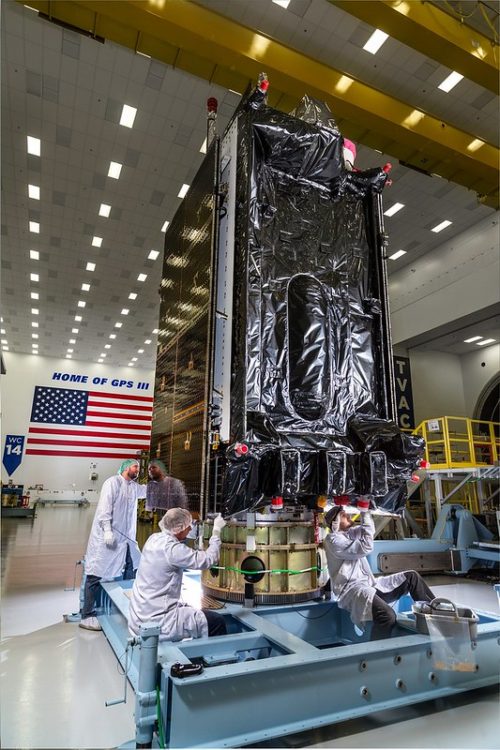
Weighing 8,500 pounds (3,900 kg) and capable of a 15-year operational lifetime, these powerful satellites are built by Lockheed Martin at its customized GPS Block III facility near Denver, Colo. They are based upon the tried-and-true A2100 “bus”, whose modular framework produces 15 kilowatts of electricity via high-efficiency solar cells, radiation-cooled traveling-wave tube assemblies and improved heat-pipe design.
The 15-year operational lifetime of each Block III bird represents a 25-percent quantum leap over earlier GPS satellite capabilities, as well as 500 times greater transmitting power, improved navigational warfare abilities, three times better accuracy and an eightfold enhancement in anti-jamming functionality.
All told, this enables GPS Block III to shut off service to limited geographical locations, whilst maintaining uninterrupted provision for U.S. and allied forces. It features a cross-linked command-and-control architecture, which permits the entire “constellation” to be updated from a singular ground station. Furthermore, the satellites showcase a “spot-beam” capability for enhanced military (“M-Code”) coverage and better resistance to hostile jamming. These enhancements are expected to lead to improved accuracy and assured availability for military and civilian GPS users worldwide.
In keeping with tradition, Block IIIs have been named in honor of explorers, with the first and second honoring “Age of Sail” navigators Amerigo Vespucci and Ferdinand Magellan. More recently, the third satellite—launched in June 2020—initially honored Christopher Columbus, but was subseqeurntly renamed to recognize the early 20th-century polar pioneer Matthew Henson.
Today’s mission pays tribute to Sacagawea, a Lemhi Shoshone woman of Idaho, who at the age of 16 assisted the Lewis and Clark Expedition to explore the Louisiasna Territory in 1803-1806. She traveled with Lewis and Clark from North Dakota to the shores of the Pacific Ocean and played an important role in establishing cultural links with Native American populations along the route.
.
.
FOLLOW AmericaSpace on Facebook and Twitter!
.




